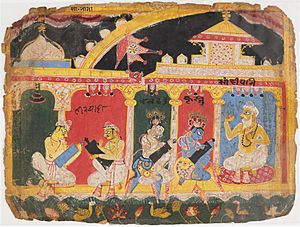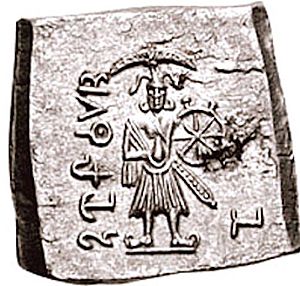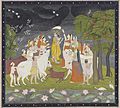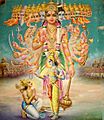Krishna facts for kids
Quick facts for kids Krishna |
|
|---|---|
 |
|
| Affiliation | Svayam Bhagavan, Paramatman, Brahman, Narayana Vishnu, Dashavatara, Radha Krishna |
| Battles | Kurukshetra War |
| Festivals | Krishna Janmashtami, Holi |
| Personal information | |
| Born | Mathura, Surasena (present-day Uttar Pradesh, India) |
| Parents | Devaki (mother) Vasudeva (father) Rohini Devi (step-mother) Yashoda (foster mother) Nanda Baba (foster father) |
| Siblings | Balarama (brother) Subhadra (sister) |
Krishna is a very important god in Hinduism. People worship him as the eighth form (or 'avatar') of the god Vishnu. Some also see him as the most powerful God himself. He is known as the god of kindness, gentleness, and love. Krishna is one of the most popular gods in India.
Hindus celebrate Krishna's birthday every year. This festival is called Krishna Janmashtami, usually in late August or early September. You often see pictures of Krishna holding a flute.
The stories about Krishna's life are called Krishna Leela. He appears in many important Hindu books and myths. These stories show him in different ways: as a child god, a playful trickster, a brave hero, and even as the supreme being of the universe. Art often shows him at different ages. For example, you might see him as a baby eating butter. Or as a young boy playing a flute. Sometimes he is shown with Radha, or as a friendly guide to Arjuna.
The name "Krishna" comes from a Sanskrit word. It means "black," "dark," or "dark blue." The name can also mean "all-attractive." Because of his name, Krishna is often shown with black or blue skin in statues and pictures.
Krishna is often shown wearing a crown with a peacock feather. He is also usually playing the bansuri, which is an Indian flute. In these pictures, he often stands with one leg bent. This pose is called Tribhanga. He is sometimes shown with cows or a calf. These animals represent him as the divine herdsman, Govinda.
Most experts believe that Krishna was a real person. He lived in India at least 1000 years before Christ. He interacted with many other important people from that time.
Contents
Amazing Stories of Krishna's Life
These stories come from old Hindu books like the Mahābhārata and the Bhagavata Purana. They take place in ancient India. Most of the events happened in areas that are now the Indian states of Uttar Pradesh, Bihar, Rajasthan, Haryana, Delhi, and Gujarat. The legends about Krishna's life are called Krishna charitas.
Krishna's Birth Story
Krishna was born to Devaki and Vasudeva in Mathura. Devaki's brother was a cruel king named Kamsa. At Devaki's wedding, fortune tellers warned Kamsa. They said that one of Devaki's children would kill him. Sometimes, the story says a voice from the sky warned him.
Kamsa decided to kill all of Devaki's children. But when Krishna was born, Vasudeva secretly carried the baby across the Yamuna River. He swapped Krishna with Yashoda's baby daughter. When Kamsa tried to kill the new baby, it changed into the goddess Yogamaya. She warned him that his killer was already in his kingdom. Then she disappeared. Krishna grew up with Nanda Baba and his wife, Yashoda. This was near modern-day Mathura. Two of Krishna's siblings also survived: Balarama and Subhadra. Hindus celebrate Krishna's birthday as Krishna Janmashtami.
Krishna's Childhood Fun
Stories of Krishna's childhood show him as a cow-herder. He was also a mischievous boy. His playful tricks earned him the nickname Makhan Chor, which means "butter thief." For example, some stories say Krishna lifted the Govardhana hill. He did this to protect the people of Vrindavana from heavy rains and floods.

Krishna's childhood stories show the Hindu idea of Lila. This means playing just for fun and enjoyment. It's not about winning or gaining something. This playful spirit is a big part of Krishna's childhood stories. Even when he fought a serpent to protect others, the stories say he was playing a game. This playfulness is celebrated during festivals like Rasa-Lila and Janmashtami. In some regions, like Maharashtra, people playfully act out his legends. They form human pyramids to break clay pots (called handis) filled with butter or buttermilk. These pots are hung high in the air, mimicking Krishna's "butter stealing."
Krishna's Adult Life and Adventures
Later, Krishna returned to Mathura. He defeated and killed the cruel king Kamsa, who was his uncle. Krishna had to stop several attempts by Kamsa to harm him. After Kamsa's death, Krishna made Kamsa's father, Ugrasena, the king again. Krishna became an important prince in the court. In one story, Krishna led the Yadavas to a new city he built called Dwaraka.
Later, the Pandava princes appeared. Krishna became good friends with Arjuna and the other Pandavas of the Kuru kingdom. Krishna played a very important role in the great epic story, the Mahabharata.
The Bhagavata Purana describes eight main wives of Krishna. These include Rukmini, Satyabhama, and Jambavati. Some experts say these wives are a way to show different parts of Krishna himself. In Hindu tradition, all of his wives are believed to be forms of the goddess Lakshmi. Lakshmi is the wife of Vishnu.
The Kurukshetra War and Bhagavad Gita
The epic poem Mahabharata tells about the Kurukshetra War. Krishna agreed to be Arjuna's charioteer (driver) in this war. But he had one condition: he would not use any weapons himself.
When they arrived at the battlefield, Arjuna saw his own family members. His grandfather, cousins, and loved ones were on the enemy side. Arjuna felt very sad. He said he could not fight and kill them. He wanted to give up his kingdom and put down his bow.
Krishna then gave Arjuna important advice. He talked about life, good and bad actions, and duties. He explained that bodies are temporary, but the soul is forever. This conversation between Krishna and Arjuna is a famous teaching called the Bhagavad Gita. It teaches about finding peace and inner freedom.
Krishna's Final Moments
One day, Krishna was sleeping. A hunter named Jara mistook him for a deer. Jara shot an arrow that hit Krishna's foot. This injury was fatal. Krishna forgave Jara before he died. The place where Krishna is believed to have died is called Bhalka. It is a pilgrimage site in Gujarat, India.
Images for kids
-
Balarama and Krishna in art from the 1st century CE.
-
Krishna with Arjuna during the Kurukshetra War. The background shows Krishna's cosmic form.
-
A 14th-century painting of Radha Krishna in Udaipur.
-
Krishna playing the flute in a temple in Nara, Japan, built in 752 CE.
See also
 In Spanish: Krishna para niños
In Spanish: Krishna para niños















